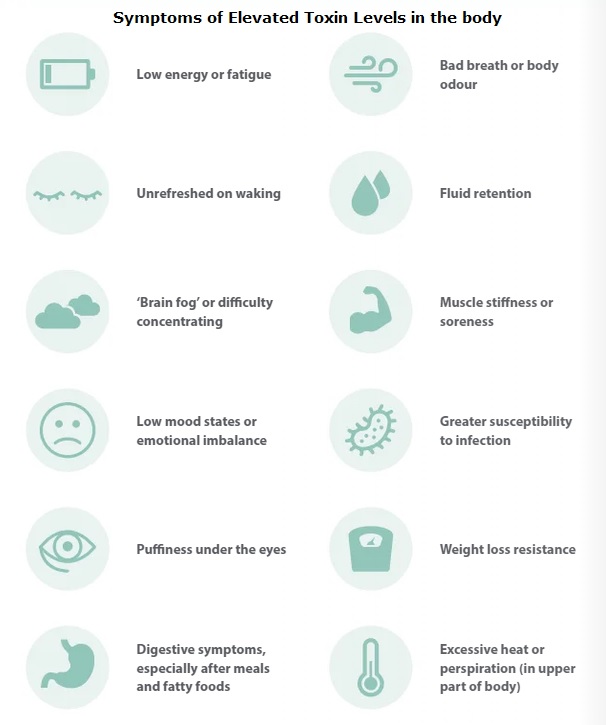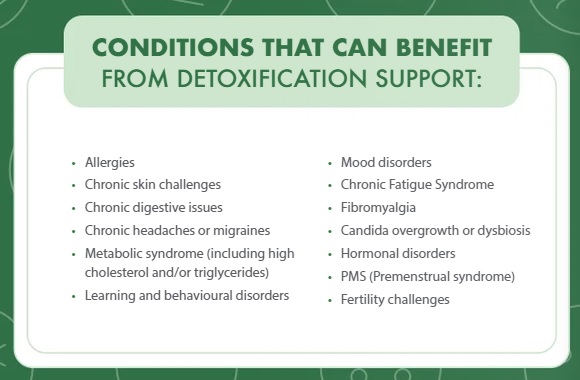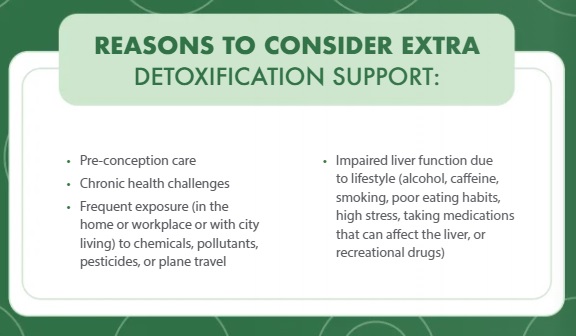In clinic the question often arises: “Why do I need to do a detox? I haven’t been exposed to any chemicals.” Allow me to dispel this myth as we have all been and continue to be exposed to toxins on a daily basis.
First, we must understand that impaired detoxification contributes to degenerative illness. Organs responsible for detoxification are the liver, intestines, kidneys, lungs, skin and lymphatic system. The body can become overwhelmed with toxins when its capacity to detoxify is impaired or when overexposure to toxins – either environmental or internally due to poor digestion – occurs.

The Chemical Abstract Service notes that in 1954 there were some 600,000 chemical compounds that had been synthesised and documented; at the end of 1993, the media reported that a Japanese research team had synthesised the 12 millionth chemical compound; while by 2009 the number had increased to 50 million. In the United States alone, a new chemical is synthesised every minute. Most of these were unknown just two generations ago. In terms of amounts, 400 million tonnes are produced annually, with about half of the chemicals in use having annual production levels exceeding 500,000 kilograms. Each year, 4.5 billion litres of pesticides are sprayed on crops in Britain alone.
Pollutants can cause inflammation either by direct contact or indirectly by stimulating an immune response. Chemicals can enter our bodies in one of three ways:
- Ingestion of food or water
- Inhalation
- Skin contact
It has been said that the environment inside the home is more polluted that outside. Toxins inside the home include formaldehyde from fabrics, carpets, furniture and bedding; plastics, car fumes from garages; cooking gas (which is particularly implicated in asthma); pine furniture; cleaning products, bleaches, glues, home office products (printing toners), air fresheners and perfumes; antimony from clothing and drinking bottles as well as medications. When inhaled in sufficient doses, chemical exposure contributes to asthma.
Some of the most toxic substances are found within cosmetics, where 89 percent of the ingredients readily used have not been evaluated for safety. Just another reason to only use natural products on your skin.
A note here: over the past few years, I have noted an alarming increase in the incidents of infants and toddlers suffering recurring tonsillitis only to have them or the adenoids removed. Children are especially vulnerable to exposure because their detoxification systems are still immature, and also because they eat and drink around seven times more than adult, have a less varied diet, breathe more than adults per kilogram of body weight and are closer to carpets and other surfaces that outgas chemicals. During pregnancy, much higher concentrations of toxins have been found in the foetus and placenta than in the mother. Hence, it can be deduced that some babies enter the world in an already toxic state.
All chemicals and toxins that enter the body must be excreted by the body. However, due to the extent of toxin exposure, damage may occur to the liver or kidneys or disrupt the nervous, reproductive, immune or cardiovascular systems.

No synthetic chemical has ever been shown to be beneficial to humans. Chemicals can exert five effects:
- Carcinogens – contribute to cancer
- Mutagens – cause abnormal cell growth that can be passed on to your babies
- Teratogens – cause miscarriage or developmental abnormalities in the foetus
- Neurotoxins – nausea neurological disorders
- Endocrine disruptors – interfere with the endocrine system and the hormones it releases.
It would, therefore, seem that we are all exposed to considerable chemicals and toxins on a daily basis. Those working within more toxic environments – painters, carpenters, motor vehicle mechanics, farmers, hairdressers, plumbers, beauty and nail therapists, printers and many more – have an even greater need to support their body’s detoxification systems.

Modern, conventionally farmed, processed foods are full of poisons, including pesticides, herbicides, binders, stabilisers, artificial flavour enhancers [such as MSG which is addictive and has been shown to lead to obesity] and chemical fertilisers. Foods are also irradiated and genetically modified. Commercially farmed grain-fed meat is even worse due to all the toxins from the grains plus hormones as well as being chemically treated to look fresh for longer.
Further sources of toxins are medicines. According to one doctor, the first lesson taught to medical students in pharmacology class is that all medicines are toxic to the body in some way. [The Gabriel Method, pp 115-117]
Our toxic lives
After reading the above, it is easy to understand that every day, all of us are exposed to a multitude of harmful chemicals in our foods, water supply and the air we breathe. That is why is is important to assist the body in eliminating harmful substances. Toxins that our body can’t eliminate are stored as fat. While some may argue that chemicals added to foods have been tested as “safe” the cumulative affect as well exposure to multiple chemicals simultaneously (as is the case in today’s world) has not been clinically tested. Visit this site for more information on environmental toxins and how they affect us: http://www.chemicalbodyburden.org/whatisbb.htm
Mad as a hatter. After the introduction of mercury into the process of hat making in the 17th century, mercurial poisoning became extremely common among the hatters in Victorian Britain. It is widely supposed that Lewis Carroll had the condition in mind when he invented the character of the Mad Hatter in “Alice’s Adventures in Wonderland”. In 2009, the sources may have changed, but mercury poisoning is still a concern. Mercury, as well as formaldehyde and some heavy metals, are still components of vaccines and amalgam fillings.
Organochlorides – a cumulative poison. Organochlorides such as PCB, DDT and dioxins persist in the environment. These environmental toxins tend to concentrate in the food chain and, therefore, in animals at the top of the food chain, such as humans. Virtually everybody in the Western world has DDT or its metabolites in their body fat, despite its use being banned in the West for more than 30 years. Studies suggest that organochlorides may be associated with negative neurological, mental and reproductive effects.
New breed of synthetic toxins. Bisphenol-A and phthalates are two classes of chemicals increasingly entering our food chain, leaching from plastic bottles, plastic food and beverage containers, carpets and fabrics. Long considered safe, long-term exposure to these chemicals has now been shown to be associated with an increased prevalence of many chronic diseases, including cardiovascular disease and diabetes. We should all be aware of the increasing levels of toxicity to which we are exposed. Air, water and food have all become sources of toxic exposure, along with internally-generated wastes. Toxic exposure is a driver of a vast range of health conditions, and detoxification has, therefore, become a necessity in order to manage our health.
Invest in your health
Optimal health, like anything worth finding and keeping, takes time and patience to achieve – and as we all know, a detox is frequently the first step to getting your body feeling alive again.
Clinical detoxification, unlike an off-the-shelf program, is specifically designed for you by a highly trained natural health care professional.
Like any investment, the best results are achieved with patience, understanding and qualified advice. At True Medicine we are pleased to offer the G.E.M.M. Protocol which stimulates your natural detoxification pathways by support Nrf2 production and protecting your DNA.
In today’s society, the majority of people are afforded very little time to consider their health and wellbeing. There also still appears to be a significant amount of reluctance to spend money on health … unless of course someone becomes unwell. There is great emphasis to ‘invest’ in our future, through various superannuation and other investment schemes. We must realise, however, that to make the most of our future, at some point, we need to begin to invest in our health and wellbeing.
